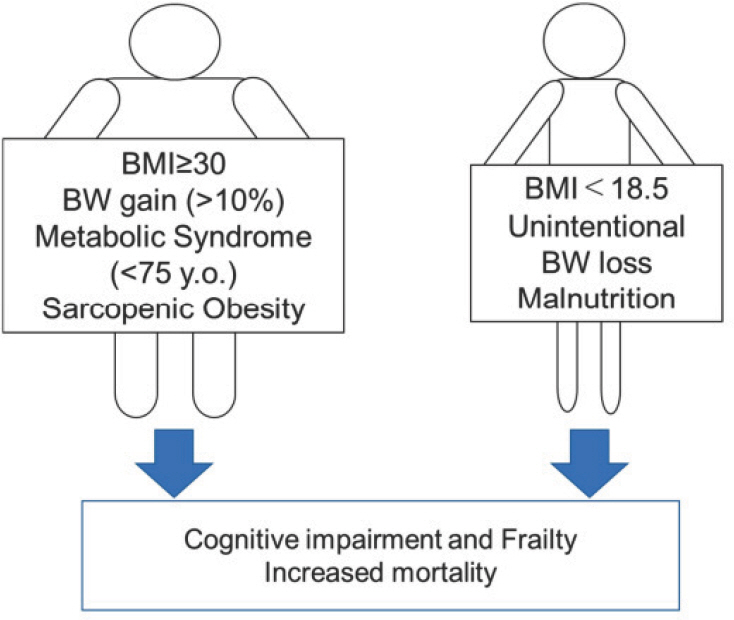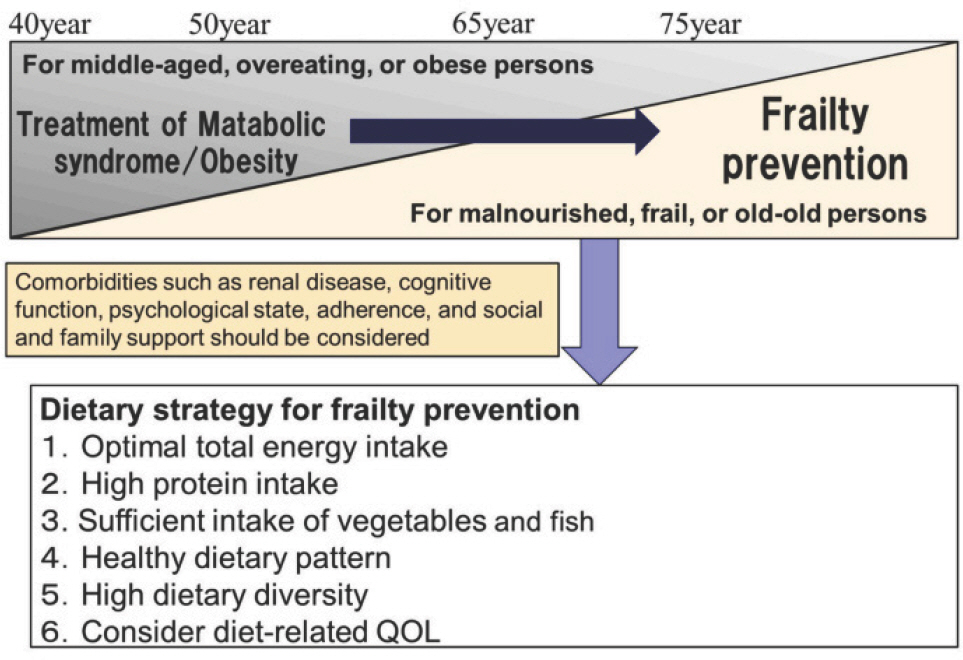J Korean Diabetes.
2022 Dec;23(4):258-261. 10.4093/jkd.2022.23.4.258.
Nutrition Therapy for Diabetic Patients with Malnutrition
- Affiliations
-
- 1Department of Nutrition, Chungnam National University Sejong Hospital, Sejong, Korea
- KMID: 2538096
- DOI: http://doi.org/10.4093/jkd.2022.23.4.258
Abstract
- Recently, the prevalence of diabetic mellitus patients in Korea has been increasing, and it increasing with age. The treatment goal of diabetes is to prevent complications through blood sugar management, for which it is important to maintain an appropriate nutritional state. Unbalanced diet refers to excessive or insufficient nutrition, which can be generally confirmed through weight conditions. Therefore, medical nutrition therapy in diabetic patients with unbalanced diet aims to maintain a moderate body mass index. Older people with diabetes have a higher risk of unbalanced diet than those without diabetes. Clinical nutritional intervention in diabetic patients should shift from strict dietary restrictions for treatment of metabolic syndrome/obesity to diet for prevention of frailty and sarcopenia with age. Therefore, clinical nutrition therapy for diabetic patients with unbalanced diet should be individualized in consideration of age, gender, and medical condition. Medical nutrition therapy tailored for each patient can contribute to improving the nutritional status of diabetic patients, prolonging healthy life expectancy and improving quality of life.
Figure
Reference
-
1.Korea Disease Control and Prevention Agency. Chronic disease prevention and management: diabetes. Available from: https://health.kdca.go.kr/healthinfo/biz/health/gnrlzHealthInfo/gnrlzHealthInfo/gnrlzHealthInfoView.do?cntnts_sn=5305 (updated 2022 Oct 14).2.Korean Diabetes Association. Clinical practice guidelines for diabetes. 7th ed.Seoul: Korean Diabetes Association;2021.3.Guh DP., Zhang W., Bansback N., Amarsi Z., Birmingham CL., Anis AH. The incidence of co-morbidities related to obesity and overweight: a systematic review and me-ta-analysis. BMC Public Health. 2009. 9:88.4.Tanaka S., Tanaka S., Iimuro S., Akanuma Y., Ohashi Y., Yamada N., Japan Diabetes Complications Study Group and the Japanese Elderly Diabetes Intervention Trial Group, et al. Body mass index and mortality among Japanese patients with type 2 diabetes: pooled analysis of the Japan diabetes complications study and the Japanese elderly diabetes intervention trial. J Clin Endocrinol Metab. 2014. 99:E2692–6.5.Schaap LA., Koster A., Visser M. Adiposity, muscle mass, and muscle strength in relation to functional decline in older persons. Epidemiol Rev. 2013. 35:51–65.6.Watanabe D., Yoshida T., Watanabe Y., Yamada Y., Kimura M; Kyoto-Kameoka Study Group. A U-shaped relationship between the prevalence of frailty and body mass index in community-dwelling Japanese older adults: the Kyo-to-Kameoka study. J Clin Med. 2020. 9:1367.7.Gregg EW., Lin J., Bardenheier B., Chen H., Rejeski WJ., Zhuo X, et al. Impact of intensive lifestyle intervention on disability-free life expectancy: the Look AHEAD study. Diabetes Care. 2018. 41:1040–8.8.Nam GE., Park YG., Han K., Kim MK., Koh ES., Kim ES, et al. BMI, weight change, and dementia risk in patients with new-onset type 2 diabetes: a nationwide cohort study. Diabetes Care. 2019. 42:1217–24.9.Cederholm T., Jensen GL., Correia MITD., Gonzalez MC., Fukushima R., Higashiguchi T, et al. GLIM criteria for the diagnosis of malnutrition- a consensus report from the global clinical nutrition community. Clin Nutr. 2019. 38:1–9.10.Turnbull PJ., Sinclair AJ. Evaluation of nutritional status and its relationship with functional status in older citizens with diabetes mellitus using the mini nutritional assessment (MNA) tool--a preliminary investigation. J Nutr Health Aging. 2002. 6:185–9.11.Tamura Y., Omura T., Toyoshima K., Araki A. Nutrition management in older adults with diabetes: a review on the importance of shifting prevention strategies from metabolic syndrome to frailty. Nutrients. 2020. 12:3367.12.Granic A., Sayer AA., Robinson SM. Dietary patterns, skel-etal muscle health, and sarcopenia in older adults. Nutrients. 2019. 11:745.13.Rashidi Pour Fard N., Amirabdollahian F., Haghighatdoost F. Dietary patterns and frailty: a systematic review and meta-analysis. Nutr Rev. 2019. 77:498–513.14.Iimuro S., Yoshimura Y., Umegaki H., Sakurai T., Araki A., Ohashi Y, et al. Dietary pattern and mortality in Japanese elderly patients with type 2 diabetes mellitus: does a vegetable- and fish-rich diet improve mortality? An explanato-ry study. Geriatr Gerontol Int. 2012. 12(Suppl 1):59–67.15.Tepper S., Alter Sivashensky A., Rivkah Shahar D., Geva D., Cukierman-Yaffe T. The association between Mediterra-nean Diet and the risk of falls and physical function indi-ces in older type 2 diabetic people varies by age. Nutrients. 2018. 10:767.
- Full Text Links
- Actions
-
Cited
- CITED
-
- Close
- Share
- Similar articles
-
- Nutrition Management of Patients with Diabetic Gastroparesis
- Nutritional Intervention for a Patient with Diabetic Nephropathy
- Malnutrition risk, nutritional knowledge, and dietary intake in chronic kidney disease patients on hemodialysis: comparison according to coexisting diabetes
- Advantages of enteral nutrition
- Nutritional therapy in hospital



